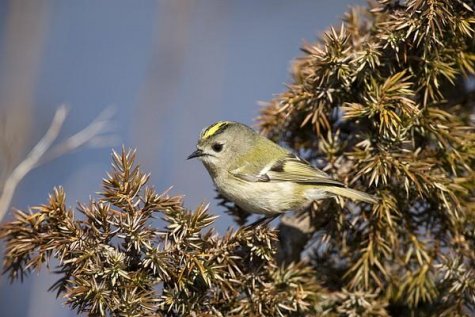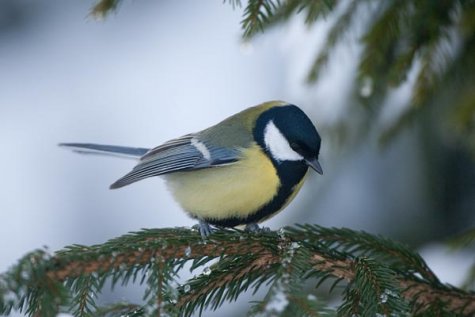Forest birds and their song - goldcrest, great tit
Nature sounds and descriptions: Veljo Runnel, www.loodusheli.ee
Observations table and logics: Vello Keppart
Photos: Arne Ader
Translation: Liis
Our forests are full of bird song - there is indeed something to hear. A series of simple everyday introductions to forest birds will follow here, to make them easier to identify by ear and also to find comparisons on the same page when needed.
Goldcrest
|
Goldcrest |
Pöialpoiss |
The goldcrest is the smallest bird in Estonia and in Europe. It has a very thin voice. The song, reminding of a violin, is so high-pitched that older people cannot hear it. The goldcrest’s song can be heard in CONIFEROUS and MIXED FORESTS. It usually keeps to the crowns of high spruces. In the mornings it begins singing 30-50 minutes before sunrise, in the evening it stops already some time before sunset. The last ones singing can be heard in the second half of July or in August, even in September in exceptional cases. The call resembles the corresponding call of tits.
Kõrv loodusesse, Ear into nature: Goldcrest
You are missing some Flash content that should appear here! Perhaps your browser cannot display it, or maybe it did not initialize correctly.
|
Most common forest birds:
Basis: spot monitoring survey in Kaarepere forest, 1984-1992) |
In how many spots á 5 minutes must you listen to hear the species?
|
How many times is the bird heard during 5 mins.?
|
LK presentation order (non-migrant* + migrant birds)
|
|
Chaffinch - Metsvint
|
1
|
2,2
|
Great tit*
|
|
Willow warbler - Salu-lehelind
|
2
|
0,8
|
Goldcrest*
|
|
Wood warbler - Mets-lehelind
|
2
|
0,8
|
Great spotted woodpecker*
|
|
Chiff-chaff - Väike-lehelind
|
2
|
0,8
|
Treecreeper*
|
|
Tree pipit - Metskiur
|
2
|
0,7
|
Jay*
|
|
Robin - Punarind
|
2
|
0,6
|
Blackbird
|
|
Song thrush - Laulurästas
|
2
|
0,5
|
Chaffinch
|
|
Blackcap - Mustpea-põõsalind
|
2
|
0,5
|
Wren
|
|
Pied flycatcher - Must-kärbsenäpp
|
3
|
0,4
|
Song thrush
|
|
Wren - Käblik
|
3
|
0,4
|
Robin
|
|
Cuckoo - Kägu
|
3
|
0,4
|
Chaffinch--
|
|
Garden warbler - Aed-põõsalind
|
4
|
0,3
|
Redwing thrush
|
|
Great tit - Rasvatihane
|
4
|
0,3
|
Tree pipit
|
|
Blackbird - Musträstas
|
4
|
0,3
|
Chiff-chaff
|
|
Goldcrest - Pöialpoiss
|
4
|
0,3
|
Willow warbler
|
|
Redwing - Vainurästas
|
4
|
0,3
|
Pied flycatcher
|
|
Collared dove - Kaelustuvi
|
4
|
0,3
|
Cuckoo
|
|
Siskin - Siisike
|
5
|
0,2
|
Wood warbler
|
|
Willow tit - Põhjatihane
|
5
|
0,2
|
Blackcap
|
|
Dunnock - Võsaraat
|
5
|
0,2
|
Garden warbler
|
|
Greater spotted woodpecker - Suur-kirjurähn
|
5
|
0,2
|
|
|
Treecreeper - Porr
|
Observed each year
|
||
|
Bullfinch - Leevike
|
Observed each year
|
Spot monitoring
|
|
|
Jay - Pasknäär
|
Observed each year
|
20 obs. spots
|
|
|
á 5 minutes
|
Great tit
|
Great tit |
Rasvatihane |
The great tit stays in Estonia during the whole year. As the first bird it opens the spring season with its song: already in January its rhythmic ”sawing” begins; towards spring changing into the typical gaily sounding song „tsitsifüü tsitsifüü ...“ („sitsikleit sitsikleit“). (from the book, ”Eesti laululinnud – Estonian songbirds” by Rootsmäe and Veroman pp 215-216). Some individuals can imitate other birds. The register of calls is similarly very varied. Up to 50 different calls have been noted for the great tit. In the morning the great tit begins singing up to one hour before sunrise and stops in the evening a little after sunset.
Kõrv loodusesse - Ear into nature: Great tit










